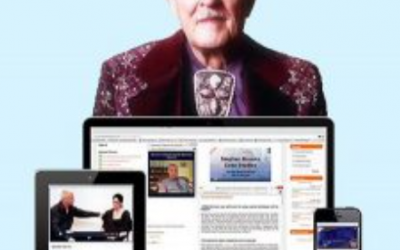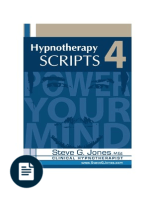🌟 New Year Offer 🌟
Celebrate 2026 with 30% OFF on all products! Use code: NEWYEAR2026. Hurry, offer ends soon!
High Quality Information Gathering and Application of Therapeutic Nominalisations Recognising the Minimum Cues for Trance Creating Dependent Tips
Stephen Brooks – Hypnotherapy Lectures – Part 1
(*1*)
The course is based around 120 essential skills & techniques These areas are covered:
Principles of indirect Hypnosis
– The Interactional Approach
– The Intrapersonal Approach
– Implication, compression, and economic language
Symptom Substitution and Resolution
– The Relationship Between Cause And Symptom
– Response Attentiveness
Positive Outcomes
– Communicating with The Unconscious
Identifying Verifiable Objectives
– Values, Criteria, and Beliefs
– Trauma and Reaction
Identifying Sabotage Strategies
– Therapeutic orientation – Change or improvement?
– Motivation of the Patient to Stay in Therapy
Future Pacing
– Indirect Benefits and Secondary Gains
– Weaning patients off therapy
– Understanding the Patient’s metaphors
– Contextualising Change
– Organic metaphors and Symptom Based metaphors
– Advanced Strategies for Dealing with Failure
– Pursuing Relevance
– The Structure of Learned Experiential Experience
– The Framing Model and Irrationality
– Contextual and time frames
Benefits and Costs
– The Laws of Attachment & Non-Attachment
– Types of decision making personality
– Anchoring, Conditioning
Feedback Loops
– The Laws of Concentrated Effort, Reversed, and Concentrated Effort
– The Laws of Positive Expectancy & Reinforcement
– The Laws of Utilization, Observation and Reframing
Indirect Hypnosis Techniques
Hypnotic Time Deformation
– Leisure Trance Inductions and Favorite Activity
– Pseudo-Hypnosis Orientation in the Time
Positive Negative Integration in Hypnosis
– The Third Person Disociation
– Hypnotic Catalepsy
– Arm Levitation Inductions
– Automated Writing in Hypnosis
– Unconscious Negotiation in Hypnosis
– Induction: Recalling Previous Trance
– Surprise Technique Inductions
– The therapeutic metaphor
– Multiple Mirror Therapeutic Induction
– Age Regression Techniques
– Paradoxical Intervention
– The Old Master induction
– Indirect Use of Sub-Modalities
– Uptime downtime induction
– Utilising The Patient’s Needs As A Motivational Strategy
Stop Smoking Strategy
– Inducing Amnesia
– The Self-Suggestion Induction
– Teach Your Patient Self-Hypnosis
– Induction to the Four Seasons
Crystal Gazing and Multiple Screens
– Non Verbal Inductions
– Ideo-Motor Signaling
– The My Friend John Induction
– Cellular Healing Therapy
– Induction to Early Learning Set
Scrambling Symptoms
– Ambiguous Task Assignments
– Eye Fixation & Distraction Inductions
– The Confusion Induction
Deep Trance Identification
– Hypnosis to Pain Control and Anaesthesia
Skills in Indirect Hypnosis
– Taking the Patient’s History
High Quality Information Gathering
– How to Create and Apply Therapeutic Nominalisations
Recognizing the Minimal Cues for Trance
– Creating Dependent Suggestions
– Open Questioning
– Positive and reverse frames and negative tags
– Sorting for patterns in association
Get your instant download Stephen Brooks – Hypnotherapy Lectures – Part 1
– Adjunctive Suggestions
– Calibrating to Positive & Negative Response Cues
– Responding to Polarity Reactions
– Classes of Double Binds
– Passive Response Suggestions
– Using Therapeutic & Hypnotic Double Entendre
– Post Hypnotic Tips
– Serial Suggestions
– Challenging Negative Numberalizations
– Sensory-Based Predicates
– Open-Ended Suggestions
– Resource Accessing
– Facial Symmetry Calibration
– Insertive Eye Contact
– Recognising Patients’ Subjective Interpretations
– Casting Doubt and Challenging a Patient’s Interpretations
– Getting Sequence Responses and Video Descriptions
– Designing Therapeutic Tasks
– Tasks to be delivered and prescribed
– Building a compassionate, empowered personality
Integrity & Ethics
– The importance patient confidentiality
Integrity and ethics in hypnotherapy practices
– When it might be more beneficial to partner with a colleague-Therapist
How to maintain patient records
– When should you stop receiving treatment?
– Ethical business management and law practice
– Current status of hypnosis, codes of practice
Hypnosis is not recommended for patients with mental or medical conditions.
– The importance and necessity of asking for feedback and following up-Up
– Recognizing psychiatric illness and when to refer
– Establishing clear guidelines about cost and duration
Practitioner Development
– CBT and humanistic psychology
– Research methodology related hypnosis
– The history and therapeutic use of hypnosis
– Objective evaluation of professional skills development
– The importance and value of supervision and continuing training
– Anatomy and basic biology
Recent developments in brain science and mind research
– Recognize how past treatment can affect therapy
The Hypnotic Relationship
– Showing compassion and sincere concern for those in need.
– Patient lifestyle and general health management.
– Patients should have the appropriate social and relationship skills.
– Support groups and resources available in the local area for patients.
– Identifying the patient’s expectations regarding outcomes
– Transference and Countertransference
– Encourage patients to become active participants in the treatment.
– Secondary and external influences that can affect therapy
– Contextualizing treatment to the patient’s environment
How to communicate clearly your therapeutic options
Emotions can influence patients’ decisions and perceptions
– How can you negotiate mutually acceptable therapeutic outcomes
– Evaluating treatment effectiveness
These 10 Lectures These are the contents of this section:
31. Positive Results
32. Responding to Polarity Reactions
33. Paradoxical Intervention
34. Communicating with the Unconscious
35. Induction to the Old Master
36. Sub-Modalities
37. Eye Accessing and Rep Systems
38. Identifying Verifiable Objectives
39. Past Life Therapy
40. Values, Criteria, Beliefs
Course Features
- Lecture 0
- Quiz 0
- Duration Lifetime access
- Skill level All levels
- Students 117
- Assessments Yes






